#Audubon Louisiana Nature Center
Explore tagged Tumblr posts
Text









A little hike at another Audubon facility
1 note
·
View note
Text
Fwd: Job: UNewOrleans.EndowedChairInBiodiversity
Begin forwarded message: > From: [email protected] > Subject: Job: UNewOrleans.EndowedChairInBiodiversity > Date: 27 February 2024 at 06:59:01 GMT > To: [email protected] > > > I would like to announce a job opening for the University of New Orleans > in Tropical Biodiversity for the evoldir. Review of applications begins > March 1st. Details can be found below: > > The Department of Biological Sciences at the University of New Orleans > announces an opening for the Doris Zemurray Stone Endowed Chair in > Biodiversity. > > This Endowed Chair, along with three other Endowed Chairs at UNO, > will collaborate with the Audubon Nature Institute as part of a > multi-disciplinary program of research and outreach to develop the next > generation of conservation professionals. The endowments provide support > for graduate students and undergraduate interns to work with the Audubon > Zoo, Audubon Aquarium, Audubon Insectarium or Freeport-McMoRan Audubon > Species Survival Center on projects of local or regional conservation > importance (including Central or South America). > > Duties include, but are not limited to, developing a robust research > program, securing extramural funds, directing graduate students, and > teaching at the undergraduate and graduate levels. > > The Endowed Chair should have a dynamic and innovative research program > centered on tropical animal biodiversity, with preference given to > those working in Central or South America. The areas of research and > taxa of interest are open, but may include invertebrate or vertebrate > animal ecology, evolutionary biology, behavior, or conservation > genetics/genomics. > > Candidates should have at least three or more years of experience at > the rank of Assistant professor or have credentials appropriate for > appointment at the rank of Associate Professor or Professor. > > Required Qualifications > > · A Ph.D. degree in Biology or relevant field. > > · Relevant postdoctoral experience. > > · Teaching experience. > > · Three or more years of experience at the rank of Assistant > Professor. > > Desired Qualifications > > · Experience obtaining independent funded research. > > · Experience mentoring graduate students in research projects. > > The University of New Orleans is an Affirmative Action and Equal > Employment Opportunity employer. We do not discriminate on the basis > of race, gender, color, religion, national origin, disability, sexual > orientation, gender identity, protected Veteran status, age if 40 or > older, or any other characteristic protected by federal, state, or > local law. > > The University of New Orleans participates in Louisiana's State As a > Model Employer plan and invites qualified individuals with disabilities > to apply. > > WorkNOLA >
0 notes
Text
Sometimes life is hard.
Sometimes I make life hard of my own volition.
That’s not really what this blog is about but the truth is there. It does feel really guilty to even think about participating in fun activities… which for one reason or another birding has become a major fun activity for me. At the same time it is also a major form of therapy… being out in nature, observing wildlife and the world around me from a distance, getting to explore beautiful areas… it all just makes it a little easier to breathe… or rather allows the opportunity to forget that you need to remember to breathe. If that make sense.
So anyway I’ve been slacking on birding again- because life is hard and busy. But I still get these daily Rare Bird Alert email blasts and a recent alert has really sent the “community” into a tizzy… a Roseate Spoonbill was observed along the Milford/Stratford shore late last week amongst a group of egrets, and has stuck around.
From the same family, and similar size, as my beloved Glossy Ibis, the Roseate Spoonbill is most commonly native to South America and the Caribbean, with the typical northern boundary of its range situated along the gulf coast of Florida, Louisiana and Texas. I read one description that describes the Roseate Spoonbill’s appearance as “stunning from a distance and bizarre up close.” As you might have guessed... I had to try and see this bird.
A number of the alerts reported great views from the observation tower at Milford Point Audubon Center, which I’ve been to before and knew even if I failed in spotting the spoonbill, I’d at least get some of that good therapy in. So I headed over today for my lunch break. Wasn’t more than ten minutes in before I spotted a new lifer for me… the Black-bellied Plover!

Side note. Any and all pictures today are going to be trash. As a sort of superstition thing, I didn’t bring with me, my gyroscope attachment that allows for halfway decent pictures with my phone through the scope. The black bellied plover is cool because it actually breeds in the northernmost arctic tundra of North America and migrate quite far south outside breeding season anywhere from the New England coast, down to the southern coasts of Chile and Brazil.
…And then out of nowhere a flash of pink caught my peripheral view.



Yes the pictures are trash. But this bird was a thing of beauty! After observing it wading for several minutes it took off, and did a majestic swooping flight out and back, up into a nearby tree. The shots don’t show how bizarre the spoon shaped bill is, nor do they show just how shocking the bright pink splash of color was amongst the gang of white egrets, and dark colored ducks nearby.
The Black-Bellied Plover was my 100th bird on my life list, followed by the Roseate Spoonbill at 101!
0 notes
Text
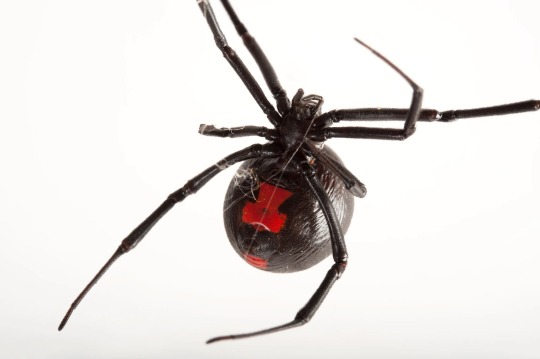
A southern black widow, Latrodectus mactans, is seen at the Audubon Nature Institute in New Orleans, Louisiana. It's one of five black widow species found throughout North America. Photograph By Joel Sartore, National Geographic, Photo Ark
Which One of These Spiders is a Black Widow?
The world of bugs is filled with lookalike species. Why?
— By Liz Langley | July 13, 2023
This will get your spidey sense tingling: There’s a type of spider that looks like a black widow—but packs a much less potent bite.
False widow spiders resemble their infamous cousins, black widow spiders, with spindly legs and globe-shaped bodies. Like black widows, these species have markings on their abdomen, though not as bright red or as distinctive as the black widow’s classic hourglass shape.
The black widow possesses venom 15 times as powerful as that of a rattlesnake. Though that sounds scary, human deaths following a bite are exceedingly rare, with none reported in the U.S. since 1983. (Get a mesmerizing look at nature’s eight-legged wonders.)
The false widow is just one example of how nature has evolved lookalikes that can make it tough for people to tell one bug apart from another.
“A lot of times these insects are trying to trick us and others around them on purpose. There’s all sorts of different types of mimicry” among Earth’s 900,000 known insect species, says Julie Peterson, an entomologist at the University of Nebraska-Lincoln.
Hoverflies, for instance, have only one line of defense: By looking just like bees, with black-and-orange markings, they hoodwink predators into not attacking them.

A composite image shows Steatoda nobilis (left), the noble false widow; S. paykulliana (center), the Mediterranean false widow; and a black widow female (right). Many false widows have abdomen shapes and markings that resemble those of black widow spiders. Photographs Via Getty Images, Left: Danut Vieru Center: Stephanie Phillips, Right: Olimbek Shrinov
That’s Probably Not a 'Murder Hornet'
In 2020, an invasive insect called the northern giant hornet arrived in Washington State. Thanks to a quick-acting campaign to eradicate their nests, none of the hornets have been seen since 2022. Even still, a two-inch-long venomous insect nicknamed the “murder hornet” (after its aggressive way of attacking bees) has kept it top of mind for many.
“We get numerous emails and calls in the spring and summer,” says George Hamilton, an entomologist at Rutgers University in New Jersey, clear on the other side of the country.
People “confuse the [invasive] European hornet and cicada killers for northern giant hornets all the time,” he says via email. (Fun fact: The U.S. has no native hornets.)
The native cicada killer is a wasp that resembles the northern giant hornet. However, the cicada killer—which rarely stings humans—has a black body with somewhat irregular yellow stripes.
Northern giant hornets are more golden in color, with consistent stripes and pointy antennae, as opposed to clubbed ones, says Chris Looney, an entomologist at the Washington State Department of Agriculture, via email.
Since northern giant hornets were never found outside of Washington or British Columbia, it’s likely that’s something else you see buzzing by, he adds.
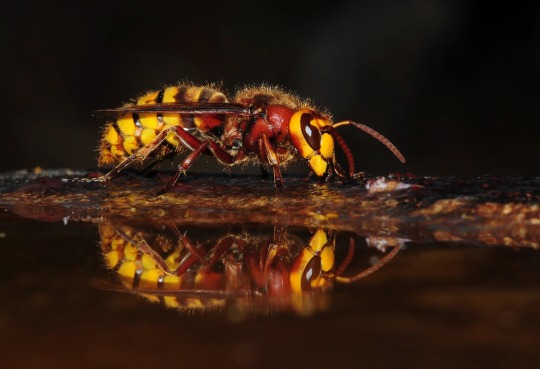
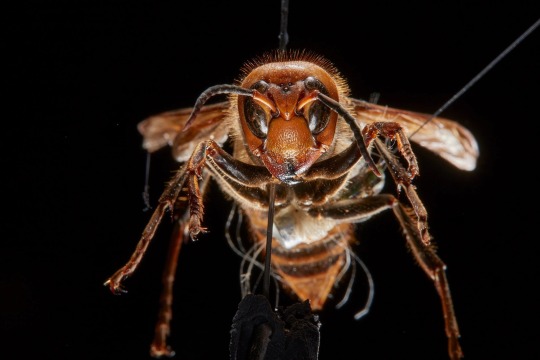
Top: The European Hornet, introduced to the U.S. in the 1800s, is the only true hornet living in North America. Photograph By Colin Varndell/Nature Picture Library Bottom: The Northern Giant Hornet, native to East Asia, has a painful bite. Photograph By Mark Thiessen, National Geographic Image Collection
Sussing Out Invaders
Sometimes, native insects look just like non-native insects, which can make controlling the invading species even more challenging.
Take the emerald ash borer, originally from East Asia, whose brilliant metallic green exoskeleton makes it look more like a Christmas ornament. After mother borers lay their eggs under the bark of ash trees, larvae hatch and devour the tree from the inside—a phenomenon that has destroyed millions of trees since the bug was first spotted in Michigan in 2002.
The emerald ash borer’s erstwhile twin is the six-spotted tiger beetle, also coated in shiny green, but with a wider body and longer legs. It’s a much speedier critter, too, catching and eating a variety of insects including ants, grasshoppers, and caterpillars.
The Japanese beetle has a metallic green head, copper body, and six poofs of white hair on each side, like frosting swirls on a cake. It’s also a defoliator of plants in the eastern U.S., Midwest, and some parts of the West. The invader is partial to some 300 species of plants and trees, including cherry, peach, and apple.
Their innocuous doppelgängers, ground beetles, have longer bodies than Japanese beetles, and they eat lots of agricultural pests, including slugs, aphids, and ants.
Recluse or Not?
Brown recluse spiders, native to the central and southern U.S., are one of only three types of venomous spiders in the U.S. Although bites are rare, they can cause painful wounds. Being brown in color, people often get them mixed up with other spiders, particularly wolf and grass spiders, says Catherine Scott, a postdoctoral researcher in entomology at McGill University in Montreal.
Scott helps manage the Twitter page “Recluse or not?”, which encourages people to send in an unidentified spider photo and get a trustworthy answer from an expert.
A good rule of thumb: Wolf and grass spiders are much larger than the brown recluse, which is light brown and barely an inch long. Wolf spiders also have two distinct dark stripes down both segments of their bodies, and grass spiders are darker in color.
Know Your Ladybugs
As well as mistaken identities, Peterson has also encountered a recognition gap between ladybug, or ladybeetle, generations that leads to indiscriminate killing of the helpful insects.
Most people know the colorful, spotted adult ladybug, found in many countries, which eats garden pests such as aphids. But fewer recognize ladybug eggs, larvae, and pupae.
Ladybug eggs look a bit like gel vitamin capsules, golden and oval-shaped, bunched together on a leaf. Larvae “look like a spiky alligator with long legs,” which can be black, yellow, and orange in color, Peterson says, while pupae resemble an orange spotted grub.
Many gardeners and others often squash these eggs, pupae, and larvae, thinking something is wrong with their plant or that the young ladybugs are some unknown pest—when the exact opposite is true, she says.

There are about 5,000 ladybug species worldwide, including this Asian lady beetle, Harmonia axyridis. Photograph By Joel Sartore, National Geographic, Photo Ark
“The larvae of ladybeetles focus on eating aphids and other kind of soft-bodied insects, whereas the adults can be a little bit more generalists,” she says, including pollen and nectar in their diets.
Having more knowledge about our tiny neighbors makes it easier to co-exist with them, Peterson says. And be kind. Bugs have the same goal as us—just trying to make it to another day.
#National Geographic#Audubon Nature Institute#Spiders#Black Widows#Danut Vieru#Stephanie Phillips#Olimbek Shrinov#Hornet 🐝#Washington State Department of Agriculture#European Hornet 🐝#Northern Giant Hornet 🐝#East Asia#Catherine Scott#McGill University in Montreal#Canada 🇨🇦
0 notes
Text
These 'eggs' are spying on whooping cranes to boost survival
With the Whooping Crane Eastern Partnership Reintroduction Project, whooping cranes nested naturally for the first time in 100 years in the Necedah National Wildlife Refuge in central Wisconsin, United States.
NEW ORLEANS (AP) — Scientists are using fake eggs to spy on whooping cranes in hopes of learning why some chicks die in the egg, while others hatch.Data gathered by the spy eggs could help biologists in Louisiana and Canada preserve the endangered long-legged birds, which have made a tenuous rebound after dwindling almost to extinction in the 1940s.
“It’s a fascinating way of spying on endangered…
View On WordPress
#Audubon Nature Institute#e Louisiana Department of Wildlife and Fisheries#North America#The Species Survival Center on New Orleans#whooping cranes
0 notes
Text
Game and Fish ponders banning turtle harvest
Suspends licensing on importing venomous snakes.
At the urging of conservation groups, the Arkansas Game and Fish Commission has sought public comment on whether it should ban the commercial trapping of freshwater turtles. States around Arkansas — Texas, Missouri, Louisiana, Tennessee and Mississippi — either limit or have banned trapping altogether. In Arkansas, commercial trappers are allowed to take an unlimited number of 14 species/subspecies of turtles from the wild. (However, two of those species aren't found in Arkansas and one does not survive shipping and handling and is not harvested, reducing the number of harvested species to 11.)
The commission included a question on the ban in an April survey seeking public comment on changes to state fishing regulations. The survey ended in May, and results will be presented to the commission at its July 19 meeting.
The Center for Biological Diversity petitioned the agency to consider the ban in August 2017. Signing on to the petition were the Arkansas Sierra Club, the Arkansas Watertrails Partnership, the Audubon Society of Central Arkansas, the Environmental Resources Center and two individuals. The petition cited declines in turtle populations from other factors — pollution, habitat loss, car strikes and incidental takes from fisheries — and said commercial harvesting was contributing to the decimation of populations.
On June 20, dozens of scientist members of the International Union for the Conservation of Nature sent a letter to the commission supporting the ban. The letter cited Arkansas trappers' figures that said more than 120,000 turtles were harvested between 2014 and 2016 from Arkansas, most of them large and sexually mature.
Keith Stephens, communications division chief for Game and Fish, said data from years 2004-17 showed 1.3 million turtles were taken from the wild in Arkansas.
Elise Bennett of the Center for Biological Diversity, who met with Game and Fish officials and trappers two weeks ago to talk about the issue, said she was told that it's likely only 60 percent of the take is being reported, so that the harvest numbers are likely much higher.
The problem with harvesting turtles is that it's not sustainable. Turtles, because they have few predators, are slow to mature, and the females lay eggs only once a year. There are many predators of eggs and hatchlings, so only a few survive predators and grow into mature, breeding individuals.
For example, because of their slow reproduction rate and egg/hatchling predation, snapping turtle populations could decline by half if only 10 percent were taken over a 15-year period, a Missouri study shows, Bennett said.
Turtles "just cannot withstand any source of removal. We're just losing them," said Janine Perlman, one of the signatories of the IUCN letter and a comparative nutritional biochemist and wildlife rehabilitator in Alexander.
Missouri banned all commercial harvesting of turtles this year, and Alabama and Florida also have bans. Other Southeastern states impose limits, including Georgia and South Carolina. Texas bans all commercial harvests on public waters and is considering expanding that to private waters.
Arkansas does ban the commercial taking of three species: alligator snappers (Macrochelys temminckii), box turtles (Terrapene spp.) and the chicken turtle (Deirochelys reticularia).
While Game and Fish has gathered information on turtle harvests, it has not been able to do population studies to determine the extent of the threat to the species that may be harvested. Bennett, however, is particularly concerned about the threat to the razorback musk turtle, because its harvest was recently banned in Louisiana, and turtle trappers there will no doubt look to Arkansas.
Most of the turtles taken are sliders, which go to the pet trade. Others are being exported to China, Bennett said, where they are used both for breeding and traditional medicine. Male turtles are canned for food.
Game and Fish spokesman Stephens said of the number of people who responded to the fisheries survey, 34 percent supported a ban, 37 percent opposed it and 29 percent had no opinion.
Turtle harvest licenses have declined sharply since 2007. That year, there were 146 turtle harvester and dealer permits, Stephens said. There were only 35 permits issued in 2017, only six of which reported harvesting turtles.
In any case, a ban on commercial harvest isn't imminent. In an email, Stephens wrote, "We don't have enough current data on overall populations to propose such a ban, but if it appears to be a significant concern with Arkansans, then we will definitely begin devoting resources to look into the status of those species further. If it was determined from the research that it is detrimental to the population of those species, then biologists would then come to the commission with proposed regulation changes, which would then be submitted for public review as well."
***
If you were planning on importing, breeding or selling venomous snakes anytime soon, don't. At its June 21 meeting, the commission decided to suspend its Wildlife Importation and Wildlife Breeder/Dealer permits for venomous or poisonous wildlife species for 120 days.
Game and Fish spokesman Randy Zellers said the suspension comes as the agency is revising its caging requirements for captive wildlife. The suspension does not affect persons already in possession of exotic or venomous species. Nor does it apply to people collecting native venomous species: If someone catches a copperhead and wants to keep it, "I wouldn't advise it, but it's not illegal," Zellers said. With the exception of birds, bats, alligator snapping turtles, ornate box turtles, hellbenders, Ouachita streambed salamanders, collared lizards and cave-dwelling or endangered species, people may hand-catch and keep up to six animals of native nongame wildlife species.
"We do have caging requirements for large carnivores and things like that, but nothing for the poisonous or venomous animals that are coming over," Zellers said.
Rattlesnake researcher Dr. Steven Beaupre, who is an ex-officio member of the commission, advised commissioners that the University of Arkansas, where Beaupre is a biology professor, must meet certain standards in its facilities for venomous or poisonous creatures "to prevent escapes or mishandling that could cause a dangerous situation." Beaupre has often been called by public safety officers to help remove venomous snakes from people's homes.
In what might be the weirdest story having to do with imported snakes in Arkansas, in 2004, Garrick Wales of Scotland, U.K., was found dead in a rental car at the Little Rock Regional Airport after receiving a shipment of four venomous snakes: a 14-inch twig snake, a 6-foot green mamba, a 4-foot black mamba and a 5-foot forest cobra in a wooden box. The state medical examiner confirmed he'd died of snakebite, though he didn't identify which snake bit Wales. (Oddly, the box of snakes was not in the car; a truck driver found the box about a half-mile from the car.) Arkansas has required importation permits since 2001; Wales had no permit.
Game and Fish ponders banning turtle harvest
1 note
·
View note
Text
Eskew+Dumez+Ripple Architects New Orleans
Eskew+Dumez+Ripple Architects USA, Design Studio New Orleans, Louisiana Buildings Images
Eskew+Dumez+Ripple Architects
Contemporary American Architectural Practice – design studio based in Louisiana, United States
Eskew+Dumez+Ripple News
Eskew+Dumez+Ripple Architects News, chronological:
Oct 31, 2020
We announce an upcoming virtual event RISING: Symposium for Climate & Equity which draws a dynamic, national group of architects, consultants, engineers, and community leaders together to connect Climate and Equity throughout the series.
Local mentors share their experience with peer groups, elevating the local baselines: “The AIA New Orleans and its newly formed 2030 Committee invite you to a dynamic event in which we will explore how architects can be active participants of building sustainable cities that are inclusive by taking action from the point of view of the professional, the practice, the community and the globe.”
Here is a list of speakers and mentors with their bios included: https://2030.aianeworleans.org/speakers-mentors
RISING is a four-part, webinar only series offered on zoom throughout the month of November on 4, 11, 18, and 24, 2020.
Each day, the series will be live from 3-5 PM CST. Open to both AIA members and non-members, visit the event website for more info on tickets here: www.aianeworleans.org/event/2030symposium/
EskewDumezRipple are involved in the event.
Sep 11, 2019 Bruce Museum, Greenwich, Connecticut, USA Design: EskewDumezRipple image courtesy of architecture office Bruce Museum Building Construction has started on the first phase of the Bruce Museum in Greenwich. The Museum, a community based, world-class institution highlighting art, science and natural history, is now underway with a multi-phase renovation and expansion of the existing museum’s exhibit galleries and support spaces.
Dec 15, 2018 Miller Park Chattanooga Innovation District, Chattanooga, Tennessee, USA Design: Spackman Mossop Michaels, landscape architecture firm & Eskew Dumez Ripple image Courtesy Spackman Mossop Michaels Miller Park Chattanooga Innovation District
Jul 28, 2018 Ace Hotel, Warehouse District, New Orleans, LA, USA photography: Timothy Hursley; Fran Parente; Simon Watson Ace Hotel in New Orleans The Ace Hotel New Orleans is located on a corner lot in the historic within walking distance of a gourmet grocery, upscale retail establishments, and a variety of fine dining options. This 184,000-sqft mixed-use development centered around the renovation of an existing 9-story circa 1928 building.
Jul 12, 2018 Crescent Park, Mississippi River, New Orleans, LA, USA photo : Timothy Hursley Crescent Park New Orleans Part of a larger master plan that envisions a new, greener future for the City of New Orleans and its riverfront, Crescent Park was designed to reconnect people with the river and transform the remnants of the city’s industrial and maritime past into a verdant, accessible, community asset.
Jun 27, 2018 The Shop at the CAC, Louisiana, USA photo courtesy of The Chicago Athenaeum The Shop at the CAC New Orleans The Shop is a comprehensive co-working development at the Contemporary Arts Center, New Orleans (CAC). Targeting technology, arts, and cultural-based businesses; The Shop serves as a hub of entrepreneurship in the developing Downtown innovation corridor.
Dec 12, 2013 Statement Honoring Allen Eskew, FAIA
R. Allen Eskew, FAIA, visionary leader of the New Orleans’ architectural community passed away on Tuesday, December 10, 2013. He was 65 years old.
Many will remember him for his built works and endless contributions to the civic and social fabric of New Orleans and the Gulf Coast Region. Projects such as the Audubon Institute’s Aquarium of the Americas, the Shaw Center for the Arts, Downtown New Orleans’ Champions Square, the award-winning Reinventing the Crescent Master Plan and its first phase, Crescent Park, to name a few. All bear the signature of a modern-day urban philosopher, designer extraordinaire, environmental and cultural steward, and community champion.
“Allen Eskew represented the best of architects and architecture,” offered Robert Ivy, FAIA, Chief Executive Officer of the American Institute of Architects. “His life was marked by a passion and drive toward excellence that touched all who knew him or visited the places and spaces he created throughout his lifetime. Working in collaboration with other talented architects and planners, he created a body of enviable work, from master planning the New Orleans World’s Fair to individual buildings ranging from civic enrichment to university research. Allen’s infectious joy and his serious efforts made the world a better place.”
One can argue that buildings are the lasting legacy of any architect worth remembering. However, in Allen’s case, it can be argued that his greatest contributions and achievements are not framed by steel, glass, or mortar, but rather in the context of how they came to be. In an era of ever-increasing polarity, Allen had an uncanny knack for building consensus and progress through thoughtful discussion, creative thinking, the insertion of levity, and meaningful dialogue. Poised and confident, he led with humility, charm and an intellectual generosity that evokes a contemporary mash-up of Atticus Finch and “the Dude.”
Allen’s work represents one man’s commitment to design as craft, but, more importantly, it speaks volumes to the character of a larger, deeply personal vision and the modus operandi of a humble civic leader and engaged citizen-architect. Allen always spoke passionately of his work and leadership in managing the 1984 Louisiana World Exposition.
Seen as a seminal moment in his career, the massive undertaking prompted Allen to establish his own firm, Eskew, Vogt, Salvato & Filson, in the spring of 1986. The practice would continue to evolve and became Eskew+Dumez+Ripple in 2000. Over the course of this period, Eskew would cultivate and nurture a design studio of national prominence and distinction.
Aside from his consistent investment into the physical development of the city, he went well beyond design to invest in the people who made it possible. Whether through his constant mentorship of young professionals across the region or his oft-unseen support of the entrepreneurial spinoffs from his own studio, Allen consistently placed people as his top priority. He never shied away from difficult conversations and almost rhythmically pursued change as a catalyst for positive opportunity.
“Allen went to extensive lengths to gather people around a table, be it for a design charette or a leisurely meal, and more often than not, the former morphed into the latter,” recalls Steve Dumez, his Partner and longtime colleague at the firm. “People mattered, communities mattered, culture, music and the arts mattered. Allen felt a tremendous responsibility to all of these and freely devoted his personal and professional time and resources to support them however he could.”
Allen loved New Orleans with an abiding passion that was contagious. One only need examine the critical role Allen played in the rebuilding efforts of the city and the long road to recovery following the destruction of Hurricane Katrina.
Regarding these efforts Alex Krieger, FAIA, wrote: “Ask most anyone to identify an architect consistently engaged in the voluminous, arduous, acrimonious, emotion-sapping yet crucial public discussions about the rebuilding of New Orleans following Katrina and Allen Eskew’s name will surface. He has been there: at all of the public ruminations and remains at the center of ongoing discussions. Not with the intention to seize advantage, spread theories, cajole or reprimand, but to help. Eskew believes that it is an obligation of citizenship to stay engaged, and to assist others about how to remain engaged as productively as possible.“ Without the intention to do so, Allen became one of New Orleans’ greatest champions and a deeply personal hero to so many.
Immediate funeral arrangements will be private and a memorial tribute is being planned to honor Allen’s life and legacy shortly after the New Year.
In addition, a memorial fund is being established to honor Allen’s civic and mentorship legacy. Details will be made available in the coming weeks through the Eskew+Dumez+Ripple website.
Eskew+Dumez+Ripple – Key Projects
Featured Buildings by Eskew+Dumez+Ripple, alphabetical:
L.B. Landry High School, New Orleans, Louisiana, USA Date built: 2010 image from architect L.B. Landry High School The 210,000 sqft building will serve a student population of over 900 students and contains a 1000-seat gymnasium, a 250-seat auxiliary gym and a 650-seat auditorium. Eskew+Dumez+Ripple is providing architectural services for this post-Katrina replacement high school for the Louisiana Department of Education Recovery School District. L.B. Landry High School retains an important place in the city’s history. The school was founded in 1938 as the first high school in Algiers that African-American residents could attend and the second black high school established in Orleans Parish, after McDonogh 35.
Poydras Residential Tower, New Orleans, Louisiana, USA Date built: 2010- image from architect Poydras Residential Tower This 462,000 sqft mixed-use residential tower located on New Orleans’ primary business thoroughfare is currently under construction. The building provides 250 apartments along with a 500 car residential and commercial parking garage. The ground floor contains retail spaces while the 9th floor houses a residential sky lobby and a resident amenity complex. Units are one or two bedroom rentals with a small number of two-story townhouses accessed off of the pool/amenity deck.
Prospect.1 Welcome Center, New Orleans, Louisiana, USA Date built: 2010- image from Eskew+Dumez+Ripple Architects Prospect.1 New Orleans Prospect.1 New Orleans [P.1], the largest biennial of international contemporary art ever organized in the United States, exhibited 81 artists in museums, historic buildings, and found sites throughout New Orleans from November of 2008 through January of 2009. The Welcome Center for P.1 was housed in one of these found spaces – the historic Hefler Warehouse – and serves to orient visitors to the city and this first New Orleans biennial.
More building projects by Eskew+Dumez+Ripple Architects online soon
Location: 365 Canal St, New Orleans, LA 70130, USA
New Orleans Architects Practice Information
Eskew+Dumez+Ripple Architects office based in New Orleans, Louisiana, USA
American Architects
Architect Studio News
image from architect
Eskew+Dumez+Ripple is a design-driven studio which produces diverse projects in architecture and planning by blending a signature collaborative process with professional talent, creative thinking and emerging technologies. The commitment to enhance and protect both the cultural and natural environments of the communities Eskew+Dumez+Ripple serve is evident in the beauty and technical craftsmanship of our designs and in the long-term sustainability of our projects.
Our firm views the creation of ecologically responsive design as a core value in our studio. Eskew+Dumez+Ripple promote a design approach which acknowledges the impact of finite resources as a positive contributor in the creation of an ethical architecture. The tremendous impact that buildings have on the natural environment and future generations compels us to design in a manner that conserves resources and mitigates man’s impact on the environment.
Our approach to sustainable design goes beyond mere logistics and mechanical elements. Eskew+Dumez+Ripple believe that the design itself should be uplifting to its users and inspire delight in the outside observer.
Based in New Orleans, Eskew+Dumez+Ripple use the cultural and architectural heritage of our city as a platform for a practice of national range and recognition.
American Architecture
American Architecture
New Orleans Houses
Website: Architecture
Architecture Studios
Buildings / photos for the Eskew+Dumez+Ripple Architects – Louisiana Architecture Studio page welcome
Website: www.eskewdumezripple.com
The post Eskew+Dumez+Ripple Architects New Orleans appeared first on e-architect.
0 notes
Text
New Orleans Tourism Basics
New Orleans is a must-visit destination of United States situated by the banks of Mississippi River in the state of Louisiana. It is famous for colorful nightlife and heritage of music influenced by American-African fusion. In almost every restaurant of the city, you will find wide variety of seafood. It belongs to that very few places in the world where you will find history, art, culture, music, sea cuisine all in one.
TRANSPORTATION: The Louis Armstrong New Orleans International Airport connects the city to the whole world. From here you will get different buses, streetcars shuttle almost whatever you want. New Orleans Public Belt Railroad with its six different routes of class III category nearly covers most of the places.
HISTORY: the name of New Orleans has originated from the Duke of Orleans who reigned from 1715 to 1783. Later it was nicknamed as 'The Big Easy' as musicians used to find a job quickly.
ATTRACTION: Every corner of it is full of history and recreation. From the old cemeteries to green parks, jazz concert, recreational fishing you will be amazed to see what it has in store for you. The antebellum foundation is one of the leading attraction of New Orleans offering beautiful resort in the midst of nature. New Orleans cemeteries are hauntingly beautiful and to feel the adventure explore it on your own.
The streetcar journey is an excellent experience which takes you to famous places like French quarter. Four independent district lines having a history more than 150 years old originated from downtown, encompasses nearly all areas of the metro.
The world-famous Mardi Gras is celebrated here for a fortnight. The last five days of the program contains one of the world's largest and longest parade. The recent event of the festival, "Meeting of the Courts" is one of its kind and guests feel mesmerized seeing the 3000 square feet working warehouse of Mardi Gras World.
Audubon Zoo, a part of Audubon Nature Institute covers 58 acres of area with 2000 animals inside. Jaguar Jungle, Asian Domain, Louisiana Swamp and especially jean and pants are the animals for which this place is renowned. Encompassing about 23000 square foot are The Audubon Butterfly Garden; and insectarium’s is situated here is the most substantial standing American museum solely dedicated to insects. One of the main attraction is an exhibition showing a bug's view of the insect world.
City Park is the best freshwater fishing spot in the metropolitan area. This place is exceptionally child-friendly, Eco-friendly and has a lot of spaces. Baits, live worms, and cricket are used for fishing, and the most famous catchable species is Rio Grande perch. Among all the spots in the City Park, the most famous one is City Park Casino spot and it's a must visit for all.
New Orleans is the origin of the world famous Jazz genre of music one must visit the jazz clubs and bars to enjoy it to the fullest. Even the street musicians will surprise you with their skills making you fall in love with the essence of Jazz.
HOTELS: Sheraton New Orleans Hotel at Canal street has a classic maybe cuisine and other facilities like swimming pool or fitness center. It will cost about $90 per day per head. New Orleans Marriott is a bit expensive priced at $120 is located.
Hope you have understood that it is impossible to explore the exceptional New Orleans in a short tour of few days. If you have a short span of time spend at least one day each in a Jazz club, Mardi Gras, City Park, Antebellum and you will cherish the sweet memories for your lifetime.
7 notes
·
View notes
Text
A penguin being named after Zion Williamson is the good news we need

New Orleans Pelicans star Zion Williamson is likely to garner a lot of honors in his career, but none will be quite like the one bestowed upon him by the Audubon Nature Institute.
The organization, which runs a zoo and aquarium in Louisiana, named a penguin after Williamson following the teenager’s generous vow to cover the salaries of all Smoothie King Center staff over the next 30 days.
MORE: N…
View On WordPress
0 notes
Photo

I painted a #Lookdown (Selene vomer) for the irl #sundayfishsketch prompt. I loved watching the lookdown wall at @AudubonNature in New Orleans last year so much it is also my screen saver and case cover for my phone. #scicomm #fishart #sciart #selenevomer #aquarium #NewOrleans (at Audubon Louisiana Nature Center) https://www.instagram.com/p/B8tc_ZYJQjl/?igshid=12y2xm0s842bp
0 notes
Photo

#newpost https://nolachic.blog/2019/07/24/free-wednesdays-for-locals-at-audubon-nature-institute/ . . . #Summer is just about over and I'm wondering if y'all took advantage of Free Wednesday's provided by the Audubon Community Connect Program?? Every Wednesday, Orleans Parish residents with a government-issued photo ID will receive free admission with up to four guests to Audubon attractions, rotating each week from the zoo, aquarium, butterfly garden and insectarium and the planetarium at the Louisiana Nature Center. #audubonnatureinstitute, #audubonzoo, #thingstodo, #Events, #butterfly, #nola, #free, #insectiarum #aquariumofamericas #aquarium #nature #animals #kids #family, #NewOrleans #zoo @auduboninstitute #sharkexhibit #wednesday #familyfun #nolablogger #nola #NewOrleans #thingstodoinla #kidfriendly #fun #nolalife (at Audubon Zoo) https://www.instagram.com/p/B0XemR5FyuW/?igshid=1dokkjboejjfp
#newpost#summer#audubonnatureinstitute#audubonzoo#thingstodo#events#butterfly#nola#free#insectiarum#aquariumofamericas#aquarium#nature#animals#kids#family#neworleans#zoo#sharkexhibit#wednesday#familyfun#nolablogger#thingstodoinla#kidfriendly#fun#nolalife
0 notes
Text
Fwd: Job: UNewOrleans.EndowedChairInBiodiversity
Begin forwarded message: > From: [email protected] > Subject: Job: UNewOrleans.EndowedChairInBiodiversity > Date: 9 February 2024 at 06:26:23 GMT > To: [email protected] > > > > > Professor - Doris Zemurray Stone Endowed Chair in Biodiversity > > The University of New Orleans is a welcoming and inclusive university > in one of America’s most diverse and culturally vibrant cities. > > The Department of Biological Sciences at the University of New Orleans > announces an opening for the Doris Zemurray Stone Endowed Chair in > Biodiversity. > > About the University of New Orleans > > - Located on the southern shore of Lake Pontchartrain, only 15 minutes > from the French Quarter, the University of New Orleans occupies a 195- > acre campus in one of the finest residential areas of the city. > - Ranked Top 50 in the Nation for Social Mobility by U.S. News & > World Report. > - The Brookings Institution ranked UNO third in the nation for providing > equal access to higher education for students from all income levels. > - For years, UNO has appeared on U.S. News & World Report’s least debt > list (schools whose graduates have the least amount of debt) among > national universities. > > UNO Welcomes Job Applicants from Diverse Backgrounds > > Founded in 1958, the University of New Orleans was the first integrated > university to open in the South. Given its history of educational access > for all, UNO is committed to fostering diversity, equity, and inclusion - > core values that inform all we do. > > Job Summary > > This Endowed Chair, along with three other Endowed Chairs at UNO, > will collaborate with the Audubon Nature Institute as part of a > multi-disciplinary program of research and outreach to develop the next > generation of conservation professionals. The endowments provide support > for graduate students and undergraduate interns to work with the Audubon > Zoo, Audubon Aquarium, Audubon Insectarium or Freeport-McMoRan Audubon > Species Survival Center on projects of local or regional conservation > importance (including Central or South America). > > Duties include, but are not limited to, developing a robust research > program, securing extramural funds, directing graduate students, and > teaching at the undergraduate and graduate levels. > > The Endowed Chair should have a dynamic and innovative research program > centered on tropical animal biodiversity, with preference given to > those working in Central or South America. The areas of research and > taxa of interest are open, but may include invertebrate or vertebrate > animal ecology, evolutionary biology, behavior, or conservation > genetics/genomics. > > Candidates should have at least three or more years of experience at > the rank of Assistant professor or have credentials appropriate for > appointment at the rank of Associate Professor or Professor. > > Required Qualifications > > · A Ph.D. degree in Biology or relevant field. > · Relevant postdoctoral experience. > · Teaching experience. > · Three or more years of experience at the rank of Assistant Professor. > > Desired Qualifications > > · Experience obtaining independent funded research. > · Experience mentoring graduate students in research projects. > > The University of New Orleans is an Affirmative Action and Equal > Employment Opportunity employer. We do not discriminate on the basis > of race, gender, color, religion, national origin, disability, sexual > orientation, gender identity, protected Veteran status, age if 40 or > older, or any other characteristic protected by federal, state, or > local law. > > The University of New Orleans participates in Louisiana's State As a > Model Employer plan and invites qualified individuals with disabilities > to apply. > > For further inquiries, please contact Nicola Anthony at [email protected] > > Nicola Mary Anthony
0 notes
Text

Pelicans, spoonbills, and herons nest on Cat Island, where oil washed ashore in May 2010. The spill sped the land’s ongoing erosion; today it’s underwater. Photo: Daniel Beltrá
Ten Years Later: Reflections on the Deepwater Horizon Oil Spill
Ten years ago, BP's Deepwater Horizon oil rig exploded, killing 11 people and pouring an estimated 4.9 million barrels of oil into the Gulf of Mexico. Audubon and other conservation partners sprang into action to repair the ecological damage.
To mark the 10th anniversary, we asked four writers to reflect on how this catastrophe has impacted people and birds over the last decade—and exactly what it will take to ensure a bright future for the gulf.
Audubon magazine asked four writers to contemplate what has and hasn't changed in the aftermath of the Gulf catastrophe.
The worst oil spill in U.S. waters began with a deadly explosion on April 20, 2010. Many of us remember the distress we felt as that day stretched into days, then months—a slow-building dread that no one could make a gaping hole drilled into the earth stop gushing. Capping the well took 87 days. The consequences unfurled long after.
Today BP penalty funds flowing to the region provide an enormous opportunity to not only repair environmental damages from that disaster, but also help restore a long-suffering Gulf Coast. In 2019 Audubon provided a roadmap for investing nearly $2 billion of this pot to shore up key habitats through 30 projects covering more than 136,000 acres. With partners, it’s now ensuring many of those projects are advancing. For example, this winter the state of Louisiana rebuilt Queen Bess Island, an eroding pelican rookery—thereby helping it avoid the fate of nearby Cat Island, which has already disappeared.
The Gulf holds all of these possibilities—tragedy, resilience, and hope. Each of the voices featured in this special package watched the Deepwater Horizon catastrophe unfold, and witnessed the repercussions to people and birds, but took away different lessons. We asked them to reflect on the spill’s political and personal legacy. What has transpired because of these horrific events? And what can we carry forward? —The Editor
We Need Another Way to Relate to the World—and Each Other
Remembering the BP spill tragedy offers an occasion for reconsidering how we interact with nature and what we value.
The first oiled pelicans I saw that spring didn’t look like the ones they put on TV. They looked almost normal at first, but an odd behavioral tic drew your gaze back to them. Then you saw that their belly feathers hung clumped and matted, looking wet, only this was oil.
Feathers protect birds from a world that is by turns too hot, too cold, too wet, too sunny—but oiled feathers can’t do their job. So the pelicans responded the only way they could. They preened, grabbing feather clumps in enormous bills and tugging over and over again. That was the tic that caught your eye, Brown Pelicans stuck in an endless preening loop, unable to save themselves but unable to stop trying. It looked like a form of insanity—I suppose it was—and I still think about the sight with a strangling sense of horror.
Brown Pelicans are highly social beings, flying together in tight, graceful formations and nesting noisily by the hundreds on sheltered islands on the fringes of coasts, feeding at sea. The edge of our world is the beginning of theirs.
They are gentle toward humans, even under stress, the wildlife rehabilitators would tell me. The muscular, seafaring Northern Gannets left triangular gashes on the forearms of people who offered them help they couldn’t understand, but the pelicans were patient as their eyeballs and palates were swabbed, quiet as their skin and feathers were scrubbed.
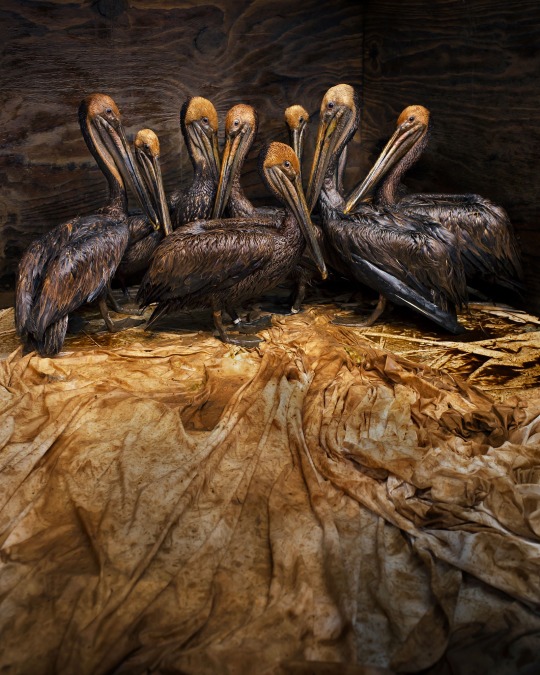
Oiled Brown Pelicans wait to be cleaned in June 2010, at a rescue center in Fort Jackson, Louisiana. Photo: Daniel Beltrá
I’d seen the Brown Pelicans at peace, just two weeks before the fog of madness began to seep in. It was evening on Louisiana’s California Bay, and the setting sun made the grass look as green as anything in this world. The pelicans packed onto a small island, inches apart, pairs sitting on mound nests on the ground, fearless. They had come off the endangered species list only months ago, the success story of a species rebounding after brutal overhunting and DDT poisoning. The rescue effort had worked. It seemed we had found a way to live together after all.
And then oil began roaring out of a violent bore in the seafloor, as if eager to make up for eons in the underworld. Eleven men died in chaos and terror. Humanity proved powerless against the onslaught. It would take a few more spins of this Earth around its axis, but wind and tides would bring that oil to the heart of the pelicans’ sanctuary.
The oil reached many other birds, too. I’d see adolescent Roseate Spoonbills, their pink feathers brown with oil, drowning Laughing Gulls, and doomed Royal Tern chicks. I would see the human toll: Servers weeping in restaurants. Businesses shuttered, communities scattered, families separated. Seafood industries in turmoil. Jobs gone. A lost summer of tourism. A couple standing together atop a dune as wave after wave of red and orange oil washed up onto the sand. The Gulf was closed for business.
The spill marked one more stanza in the long, uneasy ballad of our relationships with one another and with all life on Earth. Just five years before, Hurricane Katrina killed more than 1,800 people and wreaked more than $160 billion of havoc. The storm was magnified by decades of environmental degradation that had turned vast wetlands into open water, leaving New Orleans exposed. Katrina’s toll was also sharply intensified by human failures and prejudices that left the poor, the elderly, the disabled, and the city’s Black and brown residents most defenseless in the face of horrendous crisis. When we fail to consider the fullness of one another’s humanity in our environmental policies, we deepen cycles of injustice and harm.
We haven’t yet learned how to live alongside pelicans, and we haven’t learned how to live alongside one another, either. As I write, news is breaking of 1 billion animals dead from Australia’s wildfires, on top of immense human cost. Ice is melting, seas are rising, coral reefs are bleaching, extinctions are accelerating, peoples are being displaced, and droughts are deepening. In 2010 we saw people, birds, dolphins, and turtles suffer and die amid Deepwater Horizon’s flames and oil. Today the scale of suffering and death unfolding as our climate warms boggles the mind, activating all our individual and collective defense mechanisms. Block. Stop. Deny. Distract. Exploit.

The slowly spreading oil slick approaches the Louisiana coast, east of the Mississippi River, two weeks after the April explosion. Photo: Daniel Beltrá
In the Gulf, the best-funded environmental restoration initiative in world history is underway, cause for great hope. At the same time, our government is slashing environmental safeguards with abandon, even the venerable Migratory Bird Treaty Act, which defended all those birds in the Gulf and held BP financially accountable for its harm.
Today the scale of suffering and death unfolding as our climate warms boggles the mind
By now we know very well that human economic and social well-being depend on a clean and healthy environment. In such challenging times, we must boldly reimagine how we will relate to that environment and to one another.
I imagine that as a society, we could build a set of environmental policies and practices that lift up every person, not just the most able, fortunate, or powerful, and certainly not just those of one favored race or class. I imagine we could be brave enough to treat every other human being as fully equal to ourselves.
I imagine too that we could build into those environmental policies and practices a commitment to the innate worth and independence of all species with whom we share this planet, from Brown Pelicans to bald cypresses. I imagine that we could value their lives beyond the utility they lend our own.
These are not primarily scientific challenges. They are choices of morality, of politics, of faith, of will, of accountability. What do you choose, and what are you going to do about it?
Author’s note, April 13, 2020:
Since my essay about the 10-year anniversary of the Deepwater Horizon oil spill went to print in Audubon’s Spring 2020 issue, the Gulf Coast has closed for business once again—this time with the rest of America. The COVID-19 pandemic tearing through our communities has created a dire catastrophe across our nation and across the world. So many aspects of this crisis are unprecedented, yet so many are familiar, too. Years of warnings by scientific and medical experts were minimized or ignored. Some government responses have been shaped by ego and greed, instead of evidence and humanity. Marginalized people are dying at higher rates in a toll that already exceeds eleven times that of Hurricane Katrina and seven times that of 9/11. Under cover of chaos, polluters are making new gains in their quest to smash safeguards that protect us all. And yet, courageous people in communities, businesses, nonprofits, governments—and most especially in healthcare—are making a difference every day. So as this crisis deepens, as the BP oil spill anniversary passes quietly, and as we note the 50th Earth Day remembrance on April 22, I ask again: In what kind of world do you want to live, and what are you going to do about it?
While working in the Gulf for Audubon, David J. Ringer was deeply involved in the emergency spill response in 2010. He’s now Audubon’s Chief Network Officer.
0 notes
Photo

New Post has been published on https://toldnews.com/technology/these-eggs-are-spying-on-whooping-cranes-to-boost-survival/
These 'eggs' are spying on whooping cranes to boost survival

Scientists are using fake eggs to spy on whooping cranes in hopes of learning why some chicks die in the egg, while others hatch.
Data gathered by the spy eggs could help biologists in Louisiana and Canada preserve the endangered long-legged birds, which have made a tenuous rebound after dwindling almost to extinction in the 1940s.
“It’s a fascinating way of spying on endangered species’ reproduction in a way that allows us to assist in the recovery,” said Dr. Axel Moehrenschlager, the Calgary Zoo’s director of conservation and science.
The Calgary Zoo lent eight of the spy eggs, more properly known as “data loggers,” to Louisiana researchers.
The Louisiana wildlife biologists swap the egg-shaped data loggers for one of the two eggs that many cranes lay. The real eggs come to Audubon Nature Institute ‘s Species Survival Center in New Orleans, where they’re incubated until they’re nearly ready to hatch … or not.
Then the biologists in Louisiana swap the real eggs back into the nests .
The electronic data loggers use infrared connections to transfer information to nearby computers. It’s sent for analysis to scientists in Calgary, where the only remaining wild natural flock of whooping cranes is based.
Whoopers are the tallest birds and rarest cranes in North America. They stand about 5 feet (1.5 meters) tall, with black-tipped wings that span nearly 7 feet (2.1 meters).
Overhunting and habitat loss cut their numbers to 21 in the 1940s, but with some help from humans the number had risen to about 850 at the end of 2018.
Louisiana is home to 74 whooping cranes in the wild.
“We’ve got some pairs that haven’t been successful, and we want to see if we could see what might be going on with them,” said Sara Zimorski, a biologist with the Louisiana Department of Wildlife and Fisheries .
“In the bigger picture, we don’t know a lot about wild nest incubation,” she said. The new information may help improve provisions for captive pairs and settings for incubators.
Richard Dunn, curator at the Species Survival Center, says he hopes to learn if he needs to tweak incubator settings to more closely mimic Louisiana’s climate, which is hotter and damper than the northern settings where previous studies were done.
A crane expert who’s not affiliated with the Louisiana effort said those are entirely reasonable aims. Scott A. Shaffer, a San José State University professor, has been working with data logger eggs since 2010 to study a variety of birds in a number of places. He said the tiny, low-power sensors that reorient tablet and smartphone displays as the devices are moved have helped drive technology that checks for egg turning, allowing second-by-second studies of eggs.
The whooping crane data logger eggs record temperature, humidity and position once a minute. They can also detect when eggs are turned — an important part of keeping developing birds healthy. They were developed by a team of Canadian and U.S. scientists who compared nests of captive whooping cranes and sandhill cranes at the Calgary Zoo’s Devonian Wildlife Conservation Centre to incubators, hoping to improve the hatching rate of incubated eggs.
Their study, published in 2012, helped people raising the cranes in Canada and the U.S. to adjust incubator temperature and humidity settings, Moehrenschlager said.
The Species Survival Center on New Orleans’ west bank houses 36 of the 163 whooping cranes currently living in captivity, including 10 destined for a new facility under construction by the Dallas Zoo . None of the birds at Audubon has yet begun nesting, Dunn said.
Zimorski and fellow Louisiana wildlife biologist Phillip Vasseur put a few data loggers out last year to be sure the birds would tolerate the intrusion of eggs being swapped in and out.
Zimorski said the birds decide much of the wild deployment, since many this year are nesting in inaccessible swamps where biologists keep tabs on them through airplane flyovers.
Both Zimorski and Dunn said there’s nowhere near enough data yet for any conclusions.
“We need a couple more years so we can get additional pairs and some years of repeat data,” Zimorski said.
#Animals#Biology#Environment#Environment and nature#Environmental conservation and preservation#General News#Lifestyle#Recreation and leisure#science#Species conservation and preservation#Wildlife#Wildlife management#Zoological parks#Zoology
0 notes
Text
We 1st heard of the Southern Garden Symposium at a lecture by Dr Neil Odenwald professor emeritus from LSU. He has been the Master of Proceedings over the symposium for years. A couple of years ago we went for the first time but had to rush home because our dog sitter was in an accident (she is fine.) Last October we were able to attend both days and had a grand time. It was the 30th year of the symposium and the theme was The Changing Nature of Gardening.
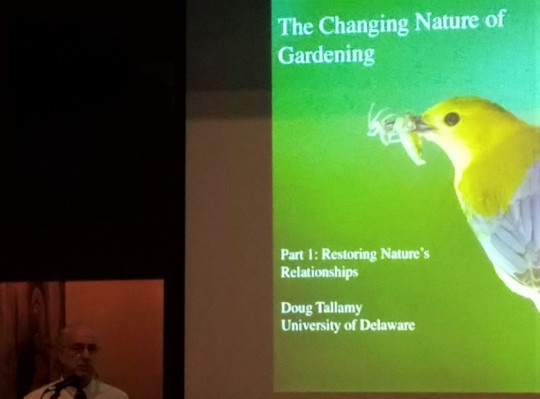
Every year they gather amazing speakers who are well know authors and gardening experts. This year Rick Darke, Doug Tallamy and Andrea Wulf, were the featured speakers. We started Friday with Nicholas Staddon. He has worked for Monrovia Nurseries for 27 years as a plant breeder, hybridizer and plant explorer. He gave a lively and highly visual presentation filled with excellent selection of plants for smaller gardens and containers. It was held in the hall at Our Lady of Mount Carmel Catholic Church Parish, which is near the center of town on a lovely property. Of course I was taken with the lichen and Spanish moss on the old wrought iron fence.
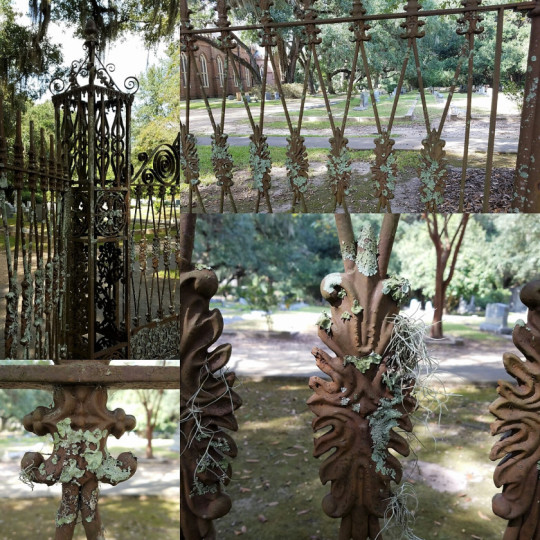
Nicholas brought many live plants which he raffled off. We came away with a beautiful ‘Lemon-Lime’ Nandina, Nandina domestica ‘Lemon-Lime’ PP24749 . It is now happily planted in our garden.
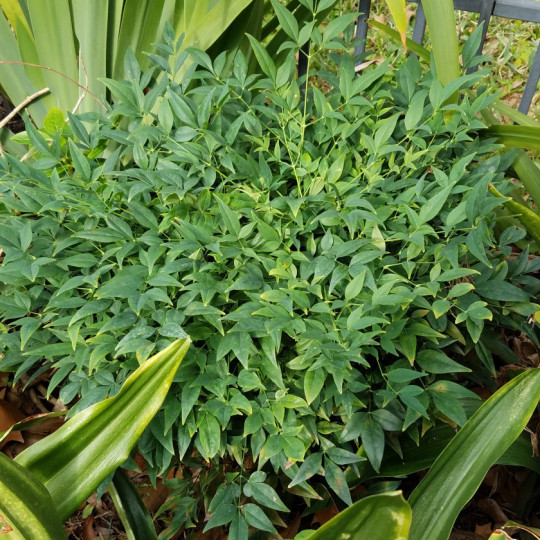
The plant I lusted for was the ‘Angyo Star’ Fatshedera x Fatshedera lizei ‘Angyo Star’. I love vines and fun leaf shapes that are variegated. I tracked it down online at The Nurseries Caroliniana Inc. and received two very happy health plants. They are now planted on our welded wire arbor.
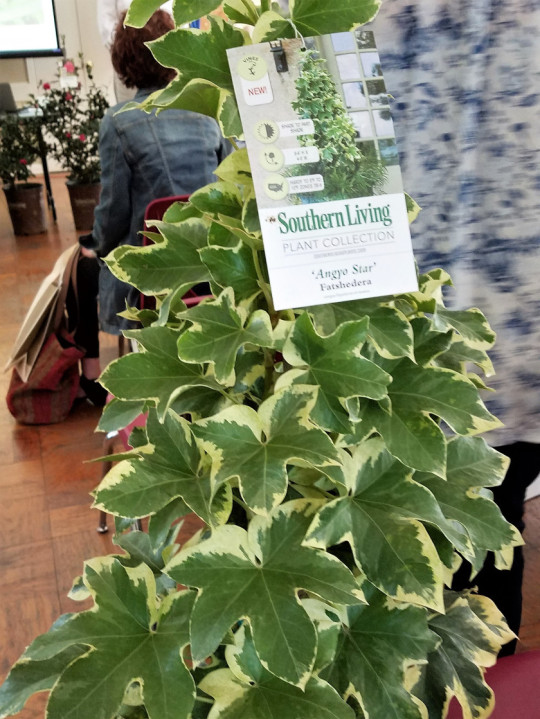
Several of the talks and social gatherings over a meal are given in nineteenth century historic plantation settings. You learn some of the history of the area while experts share their specific knowledge. The committee that puts on the SGS is amazing. Every thing goes off perfectly and you enjoy southern hospitality at every turn. All the stops are on a map and there are signs to guide you as you look for the next venue.

On the 1st day we had lunch under the giant oaks at Afton Villa Ruins Gardens, 9047 Highway 61. It is a fun place to stroll the gardens and imagine a different time. You can visit with the speakers and fellow gardeners. There is also a book and tool sale set out on the lawn.
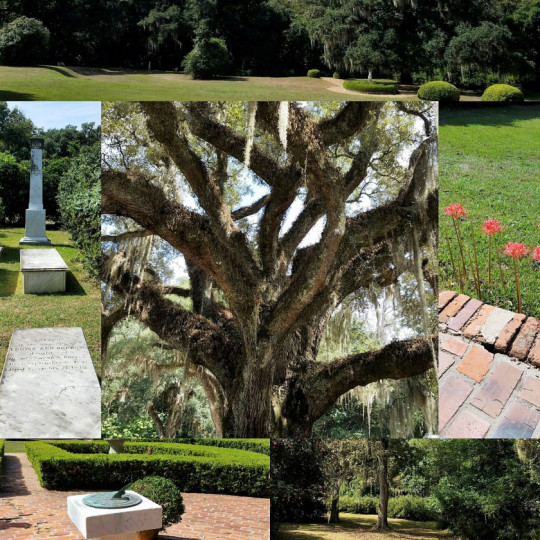
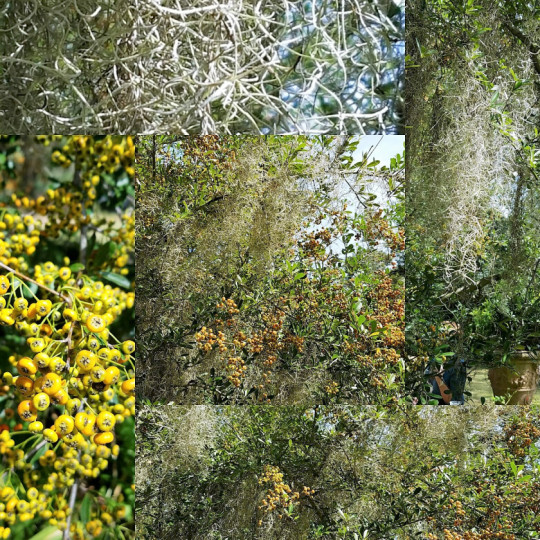
After lunch we attended a workshop by naturalist Bill Fontenot on identifying natural habitat components that are crucial to bird life and how to translate those components into human-built landscapes in a way that is both functional and beautiful. This was right down my alley. I love including plants and habitats for birds and pollinators in my garden designs.
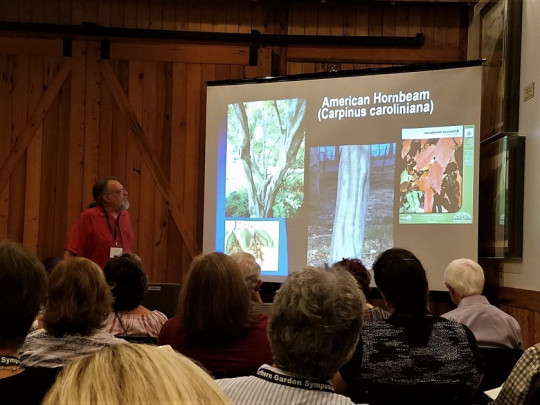
Following the program one of the park rangers gave us a guided tour of the grounds of Oakley Plantation.

We learned the artist and naturalist John James Audubon lived here briefly as a tutor to the plantation owners’ children.

Many of the plantations have beautiful Oak Allées. We learned in the time when the plantations were working farms the areas were open fields. The oaks came later when the children of the plantation inherited wealth and built more elaborate homes.
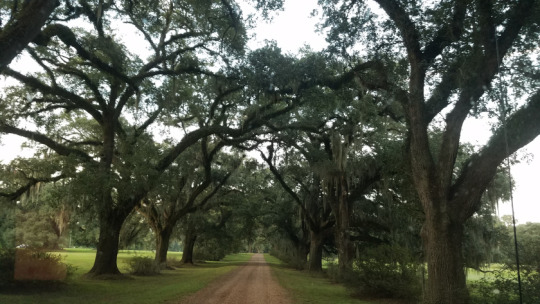
The highlight of the symposium weekend is the Speakers’ Gala. This year it was at The Oaks, the private home of Mr. and Mrs. Edward Daniel III. It was a beautiful evening out on the lawn under the graceful oaks. We enjoyed lovely live jazz in the background and delicious food set up buffet style in the main rooms of the home. I did not take any photos but the last time we went the home we dined at had a beautiful pond. This might give you a sense of how lovely the evening can be on a moonlit night in Louisiana.
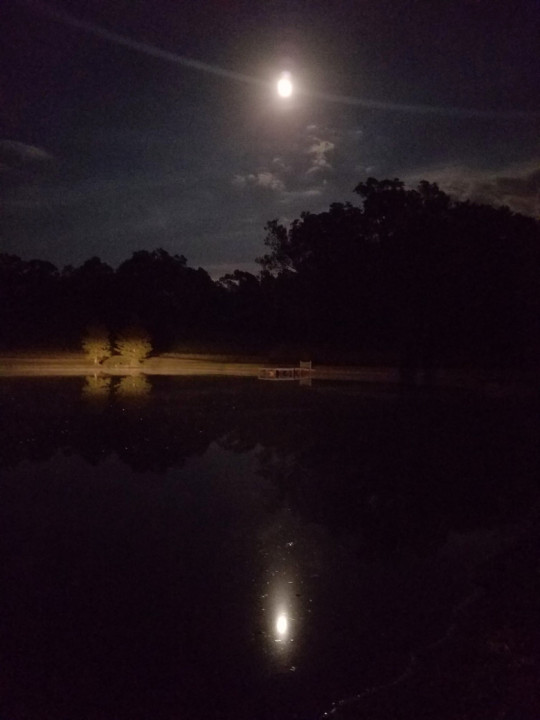
The next day started with a fabulous breakfast buffet on the terrace at Hemingbough Cultural Center. In the lobby you can browse the book sale. Inside the hall were tables set out with tantalizing items for the silent auction. Out on the drive was a big plant sale. I know we bought a few plants. Must help the cause : ) During breaks we toured the Arlin Dease’s gardens.
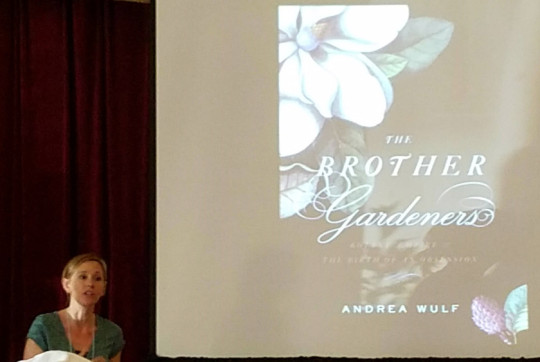
Photo from her talk in 2016
The 1st speaker was Andrea Wulf giving us insight and details on her newest book “The Invention of Nature: Alexander von Humboldt’s New World
” She is a scholar, thorough researcher and engaging speaker. Her slides included original drawing done by Von Humboldt. She goes back to original documents and his own writings to explore the history and character of this visionary and naturalist. He is credited with changing the way we understand nature today. He was one of the amazingly brave plant hunters and adventurers that risked their lives to explore unknown parts of the globe. I highly recommend all her books.
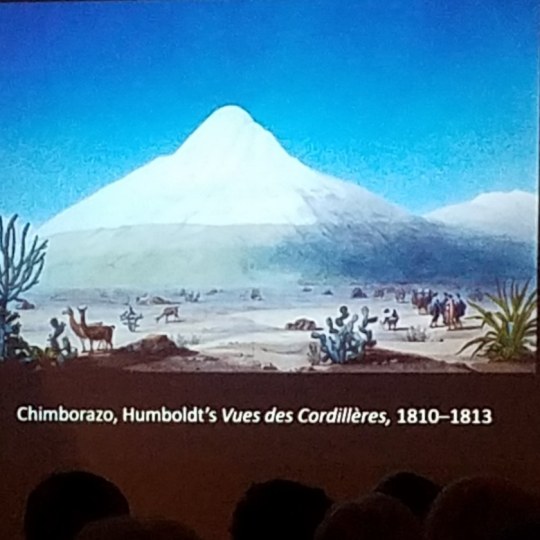
After a refreshing lunch we had a two part lecture. The Changing Nature of Gardening: given by Dr. Doug Tallamy and Rick Darke. They are co-authors of the book The Living Landscape. Part One
given by Dr. Dough Tallamy. He talked about the specialized relationships between animals and plants and how they are the norm in nature rather than the exception. He explained why our personal gardens are important to the ecosystems that sustain us and how we can use our residential landscapes to connect the isolated habitat fragments around us. He used his own garden as an example with pictures of how it has evolved over the years.
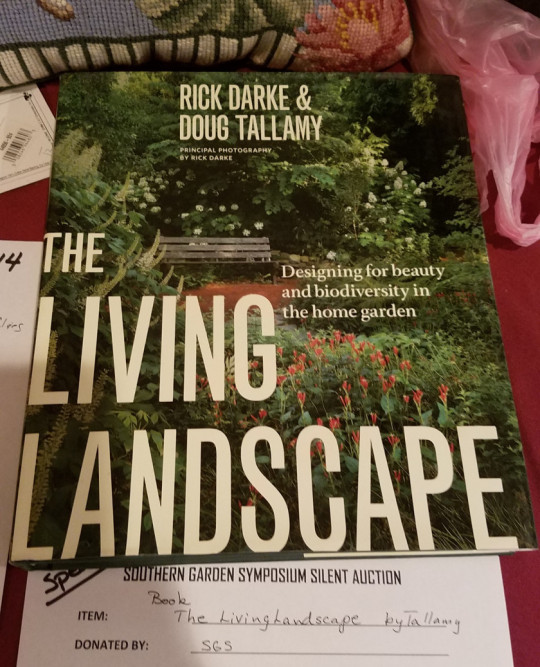
Part Two
was given by Rick Darke He explored concepts and ethics that should change the way we think of “Nature” and how we garden. “In an era when human activity is the primary factor disrupting ecological communities, the notion of Nature as a sentient other capable of restoring essential relationships is no longer helpful. Gardeners – who practice the art of nurturing life – will be key agents in repairing and sustaining living landscapes.” -RD
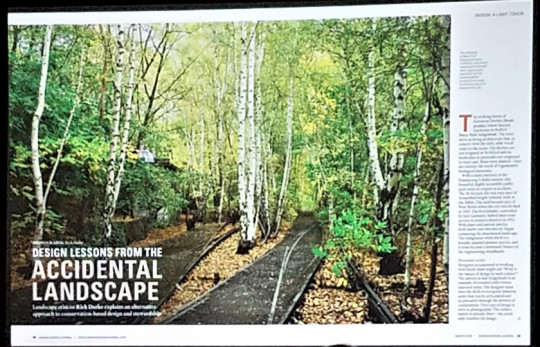
We finished off the day with afternoon tea at Hillcroft, the private home of Mr. and Mrs. Mitchel Brashier,
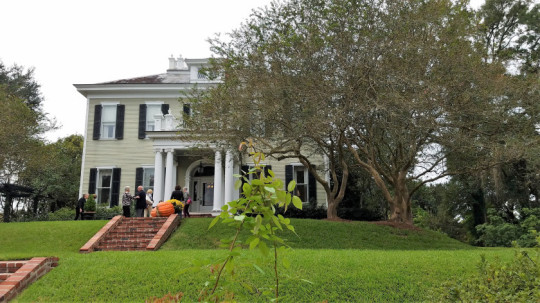
It is a lovely and lovingly restored home (circa 1905). The same year as our home but much grander. We got to tour the grounds and inside the home downstairs. I would have loved to see the view from the widow’s walk.
They even had a portrait of the home like we do.
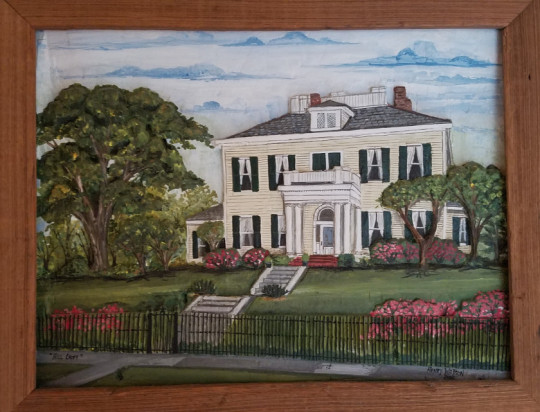
This has been a long post. I wanted you to get the feel of this symposium since it is open to the public. It does fill up quickly along with the local hotels. If you are interested you can sign up for email notices. We enjoyed it so much we are going back next year.
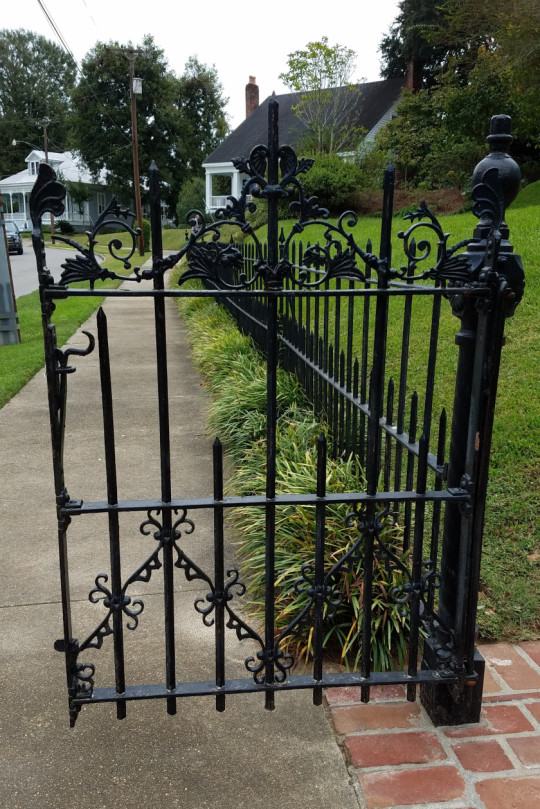
P.S. Dear Readers,
I have been out of pocket, as they say in the south, for a long time. I have been spending my blogging time and energy hanging out with my young granddaughter, ever since she was born 8/16/17. She is 17 months old now and enjoying her few days a week at daycare. I will continue to spend at least one day a week with her as long as I can. I will now have more time to blog.
Next up, our weekend in Nacogdoches Texas, attending the Southern Garden History Society program, 300 Years of Plants on the Move in Texas.
Happy Gardening from Laurin and Shawn
St. Francisville LA, The Southern Garden Symposium We 1st heard of the Southern Garden Symposium at a lecture by Dr Neil Odenwald professor emeritus from LSU.
#great gardens#Hillcroft#Nurseries Caroliniana Inc.#oak allee#Saint Francisville Louisiana#Southern Garden Symposium#southern plantation#The Changing Nature of Gardening
0 notes
Text
These ‘eggs’ are spying on whooping cranes to boost survival
NEW ORLEANS — Scientists are using fake eggs to spy on whooping cranes in hopes of learning why some chicks die in the egg, while others hatch.
Data gathered by the spy eggs could help biologists in Louisiana and Canada preserve the endangered long-legged birds, which have made a tenuous rebound after dwindling almost to extinction in the 1940s.
“It’s a fascinating way of spying on endangered species’ reproduction in a way that allows us to assist in the recovery,” said Dr. Axel Moehrenschlager, the Calgary Zoo’s director of conservation and science.
The Calgary Zoo lent eight of the spy eggs, more properly known as “data loggers,” to Louisiana researchers.
The Louisiana wildlife biologists swap the egg-shaped data loggers, which Moehrenschlager said are encased in a plastic polymer, for one of the two eggs that many cranes lay. The real eggs come to Audubon Nature Institute ‘s Species Survival Center in New Orleans, where they’re incubated until they’re nearly ready to hatch … or not.
Then the biologists in Louisiana swap the real eggs back into the nests .
The electronic data loggers use infrared connections to transfer information to nearby computers. It’s sent for analysis to scientists in Calgary, where the only remaining wild natural flock of whooping cranes is based.
Whoopers are the tallest birds and rarest cranes in North America. They stand about 5 feet (1.5 metres) tall, with black-tipped wings that span nearly 7 feet (2.1 metres).
Overhunting and habitat loss cut their numbers to 21 in the 1940s, but with some help from humans the number had risen to about 850 at the end of 2018.
Louisiana is home to 74 whooping cranes in the wild.
“We’ve got some pairs that haven’t been successful, and we want to see if we could see what might be going on with them,” said Sara Zimorski, a biologist with the Louisiana Department of Wildlife and Fisheries .
“In the bigger picture, we don’t know a lot about wild nest incubation,” she said. The new information may help improve provisions for captive pairs and settings for incubators.
Richard Dunn, curator at the Species Survival Center, says he hopes to learn if he needs to tweak incubator settings to more closely mimic Louisiana’s climate, which is hotter and damper than the northern settings where previous studies were done.
A researcher who’s not affiliated with the Louisiana effort said those are entirely reasonable aims. Scott A. Shaffer, a San Jose State University professor, has been working with data logger eggs since 2010 to study a variety of birds in a number of places. He said the tiny, low-power sensors that reorient tablet and smartphone displays as the devices are moved have helped drive technology that checks for egg turning, allowing second-by-second studies of eggs.
The whooping crane data logger eggs record temperature, humidity and position once a minute. They can also detect when eggs are turned — an important part of keeping developing birds healthy. They were developed by a team of Canadian and U.S. scientists who compared nests of captive whooping cranes and sandhill cranes at the Calgary Zoo’s Devonian Wildlife Conservation Centre to incubators, hoping to improve the hatching rate of incubated eggs.
Their study, published in 2012, helped people raising the cranes in Canada and the U.S. to adjust incubator temperature and humidity settings, Moehrenschlager said.
The Species Survival Center on New Orleans’ west bank houses 36 of the 163 whooping cranes currently living in captivity, including 10 destined for a new facility under construction by the Dallas Zoo . None of the birds at Audubon has yet begun nesting, Dunn said.
Zimorski and fellow Louisiana wildlife biologist Phillip Vasseur put a few data loggers out last year to be sure the birds would tolerate the intrusion of eggs being swapped in and out.
Zimorski said the birds decide much of the wild deployment, since many this year are nesting in inaccessible swamps where biologists keep tabs on them through airplane flyovers.
Both Zimorski and Dunn said there’s nowhere near enough data yet for any conclusions.
“We need a couple more years so we can get additional pairs and some years of repeat data,” Zimorski said.
——
This story has been corrected to show that Scott A. Shaffer is a researcher and not a crane expert.
from Financial Post http://bit.ly/2VB0MVF via IFTTT Blogger Mortgage Tumblr Mortgage Evernote Mortgage Wordpress Mortgage href="https://www.diigo.com/user/gelsi11">Diigo Mortgage
0 notes